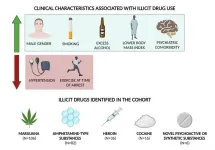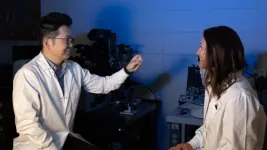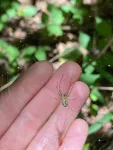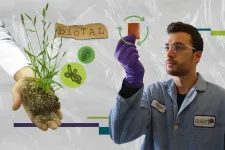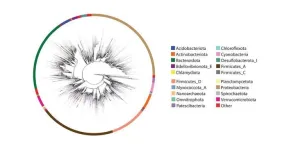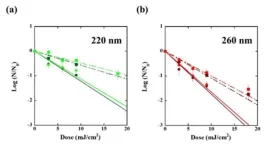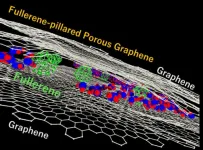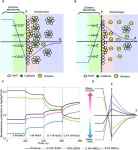Research Corporation for Science Advancement (RCSA) chooses Symplectic Grant Tracker to manage funding for innovative scientific research
2023-07-27
Digital Science, a technology company serving stakeholders across the research ecosystem, is pleased to announce that the Research Corporation for Science Advancement (RCSA) has chosen Symplectic Grant Tracker from Digital Science’s suite of flagship products to advance its aims of providing catalytic funding for innovative scientific research and the development of academic scientists.
RCSA joins the 50+ foundations, charities and funders worldwide who manage their end-to-end grant lifecycle using Symplectic Grant Tracker. Designed from the outset to meet research funding needs, Grant Tracker includes features to assist applicants, reviewers, committees and ...
Investigators identify translation gaps in instrument that measures nursing practice environment
2023-07-27
PHILADELPHIA (July 27, 2023) – Two decades ago, the Practice Environment Scale of the Nursing Work Index was published to measure the nursing practice environment. Although the instrument's use has resulted in advances in science and quality improvement efforts, its potential may be limited by the availability and quality of translations into different languages.
Researchers from the University of Pennsylvania School of Nursing (Penn Nursing) investigated published translations of the instrument and have identified ...
Illicit drug use is involved in nearly one in three sudden cardiac deaths in young adults
2023-07-27
Philadelphia, July 27, 2023 – Approximately one-third of young adults in Victoria, Australia, who experienced sudden cardiac deaths (SCDs) outside of a hospital setting from April 2019 to April 2021 used illegal drugs prior to their fatal events, reports a new study in Heart Rhythm, the official journal of the Heart Rhythm Society, the Cardiac Electrophysiology Society, and the Pediatric & Congenital Electrophysiology Society, published by Elsevier. The analysis of data on substance abuse, revealed through positive toxicology reports and patient histories and recorded in one of the world’s largest and most comprehensive SCD registries, ...
$3 million grant awarded to MU researcher for leading biomedical and agricultural innovation
2023-07-27
In a new study funded by a $3 million grant from the National Institutes of Health (NIH), University of Missouri researcher Kiho Lee, an associate professor in the College of Agriculture, Food and Natural Resources, will use gene editing to investigate the building blocks of disease. His ultimate goal — to discover clinically significant explanations for human diseases like Alzheimer’s, cancer and infertility, while working on solutions to global food insecurity.
Common diseases, such as Alzheimer’s, are widespread in humans, plaguing an estimated 11% or 6.7 million Americans over age 65, according to The ...
New study reveals that tree species diversity increases spider density
2023-07-27
Spiders are often maligned for being creepy critters, but they are some of the most environmentally friendly pest regulators. Because they actively feed on flies, moths, mosquitoes and roaches, spiders eliminate parasites and many other vectors of disease—protecting both humans and plants from harm.
A new University of Maryland-led study published online in the journal Ecology found one simple way to take advantage of this natural ecosystem service: give tree-dwelling spiders a more diverse habitat.
“We found that there’s ...
IU researchers diagnose Indianapolis Zoo orangutan with rare genetic disease
2023-07-27
NDIANAPOLIS—Researchers from Indiana University School of Medicine have diagnosed a Sumatran Orangutan at the Indianapolis Zoo with a rare genetic disease called Alkaptonuria. This is the first time the disease has been confirmed molecularly in a primate other than a human.
The six-year-old orangutan, named Mila, was born at the Indianapolis Zoo in 2016. Mila had a history of dark urine that turned brown upon standing since birth, but has never shown other symptoms. Researchers from the IU School of Medicine Department of Medical ...
New $3 million grant supports research on leading cause of maternal mortality worldwide
2023-07-27
University of Missouri researchers are striving to find solutions to the leading cause of maternal mortality in the world — preeclampsia. For Laura Schulz, an associate professor of obstetrics, gynecology and women’s health in the University of Missouri School of Medicine, understanding the root causes of preeclampsia and other complicated, life-threatening maternal conditions is pivotal in advancing women’s health care.
Supported by a renewed $3 million grant from the National Institute of Child Health and Human Development (NICHD), Schulz and her team will use ...
Making renewable, infinitely recyclable plastics using bacteria
2023-07-27
Plastic waste is a problem. Most plastics can’t be recycled, and many use finite, polluting petrochemicals as the basic ingredients. But that’s changing. In a study published today in Nature Sustainability, researchers successfully engineered microbes to make biological alternatives for the starting ingredients in an infinitely recyclable plastic known as poly(diketoenamine), or PDK.
The finding comes from collaboration among experts at three facilities at the Department of Energy’s Lawrence Berkeley National Laboratory (Berkeley Lab): the Molecular Foundry, the Joint BioEnergy Institute ...
Short bursts of daily activity linked to reduced cancer risk
2023-07-27
Promising new research suggests a total of just 4.5 minutes of vigorous activity that makes you huff and puff during daily tasks could reduce the risk of some cancers by up to 32 percent.
Published in JAMA Oncology and led by the University of Sydney, Australia, the study used data from wearable devices to track the daily activity of over 22,000 ‘non-exercisers’. Researchers then followed the group’s clinical health records for close to seven years to monitor for cancer.
As few as four to five minutes of vigorous intermittent lifestyle physical activity or ‘VILPA’ was associated with a substantially lower cancer risk compared to those who undertook no ...
Johns Hopkins Applied Physics Laboratory restores cold sensation in amputees’ phantom limbs
2023-07-27
Johns Hopkins Applied Physics Laboratory (APL) researchers have developed one of the world’s smallest, most intense and fastest refrigeration devices, the wearable thin-film thermoelectric cooler (TFTEC), and teamed with neuroscientists to help amputees perceive a sense of temperature with their phantom limbs. This advancement, one of the first of its kind, enables a useful new capability for a variety of applications, including improved prostheses, haptics for new modalities in augmented reality (AR) and thermally-modulated therapeutics for applications such as pain management. The technology also has a variety ...
New resource harmonizes 16S and shotgun sequencing data for microbiome research
2023-07-27
Two leading sequencing techniques are no longer at odds, thanks to an international effort led by scientists at University of California San Diego. In a study published July 27, 2023 in Nature Biotechnology, the researchers debuted a new reference database called Greengenes2, which makes it possible to compare and combine microbiome data derived from either 16S ribosomal RNA gene amplicon (16S) or shotgun metagenomics sequencing techniques.
“This is a significant moment in microbiome research, as we’ve effectively rescued over a decade’s worth of 16S data that might have otherwise become obsolete in the modern world ...
Preventing weight gain: Yo-yo no-go zones for Australians
2023-07-27
There’s no doubt that Aussies love a good celebration. We’re all in when it comes to the weekend, and most of us can’t go past a Christmas celebration without a little bit of overindulging. But all this comes at a cost, and it’s taking a massive toll on our waistline.
Now, a world-first study from the University of South Australia exposes the real weight gains of everyday Australians, in a move to tackle overweight and obesity.
Funded by the NHMRC, and published in JAMA Open Network today, the study explored how weight changes across a 12-month period, finding that weight fluctuated throughout the year.
Specifically, ...
Closing cancer cell’s escape route
2023-07-27
Chemotherapy and radiotherapy aim to destroy cancer cells by inducing DNA double-strand breaks – damage that, once inflicted, usually causes the cells to die. But damage to a cell’s genetic material also activates a signaling pathway called IKK/NF-κB that helps prevent cell death, thus limiting the success of these treatments in patients.
NF-κB is a family of gene regulators that controls a wide variety of cellular processes – from immune responses to embryonic development – and is activated by the enzyme complex ...
Fiber-infused ink enables 3D-printed heart muscle to beat
2023-07-27
Over the last decade, advances in 3D printing have unlocked new possibilities for bioengineers to build heart tissues and structures. Their goals include creating better in vitro platforms for discovering new therapeutics for heart disease, the leading cause of death in the United States, responsible for about one in every five deaths nationally, and using 3D-printed cardiac tissues to evaluate which treatments might work best in individual patients. A more distant aim is to fabricate implantable tissues that can heal or replace faulty or diseased structures inside a patient’s heart.
In a paper published in Nature Materials, researchers ...
New technology promises rapid and reliable development of new diagnostic tests
2023-07-27
QUT researchers have developed a new approach for designing molecular ON-OFF switches based on proteins which can be used in a multitude of biotechnological, biomedical and bioengineering applications.
The research team demonstrated that this novel approach allows them to design and build faster and more accurate diagnostic tests for detecting diseases, monitoring water quality and detecting environmental pollutants.
Professor Kirill Alexandrov, of the QUT School of Biology and Environmental ...
Jinghui Zhang, Ph.D., elected Fellow of the International Society for Computational Biology
2023-07-27
(Memphis, Tenn. – July 27, 2023) St. Jude Children’s Research Hospital proudly announces that Jinghui Zhang, Ph.D., Member of the Department of Computational Biology, has been elected as a Fellow of the International Society for Computational Biology.
Zhang is one of 15 scientists given this distinction in 2023. She’s being honored for the development and application of innovative computational methods, discovering novel targets and accelerating research and genomic data sharing to advance the diagnosis, treatment and surveillance of pediatric cancers and survivors.
“I ...
Motivation and pleasure deficits play important role in social functioning across psychiatric disorders
2023-07-27
Dr. Raymond Chan's team from the Institute of Psychology of the Chinese Academy of Sciences and his collaborators have recently shown that amotivation and anhedonia, rather than expressive dysfunction, play a crucial role in determining the social functioning of schizophrenia patients.
The study was published in Nature Mental Health.
Negative symptoms refer to the loss of normal functioning, including anhedonia, avolition, alogia, asociality, and affective blunting, and have been shown to be the most important predictors ...
Storing fat at the waist may NOT up diabetes risk, surprise findings indicate
2023-07-27
Conventional wisdom holds that storing fat around your belly puts you at increased risk for type 2 diabetes. But surprising new findings from the University of Virginia School of Medicine suggest that naturally occurring variations in our genes can lead some people to store fat at the waist but also protect them from diabetes.
The unexpected discovery provides a more nuanced view of the role of obesity in diabetes and related health conditions. It also could pave the way for more personalized medicine – treatments tailored to the individual. ...
Using cosmic weather to study which worlds could support life
2023-07-27
COLUMBUS, Ohio – As the next generation of giant, high-powered observatories begin to come online, a new study suggests that their instruments may offer scientists an unparalleled opportunity to discern what weather may be like on far-away exoplanets.
Dubbed the extremely large telescopes (ELTs), these observatories, which include the Extremely Large Telescope (ELT), the Giant Magellan Telescope (GMT), and the Thirty Meter Telescope (TMT), will be some of the largest ground-based telescopes ever built, and their instruments are expected to exceed ...
Introducing the 'Polyphenols Innovation Network': Catalyzing advances in polyphenols research
2023-07-27
Malta – We are delighted to announce the launch of the Polyphenols Innovation Network (PIN), a pioneering initiative designed to accelerate progress in the field of polyphenols research by fostering a collaborative and innovative environment.
Under the banner of PIN, our mission is to assemble a diverse team of multidisciplinary experts, committed to advancing the frontiers of polyphenols research, applications, and innovation.
Projects of PIN:
Three pioneering projects have been earmarked for initiation under the auspices ...
Study addresses use of teleneurology to improve access to outpatient care, other inequity issues
2023-07-27
INDIANAPOLIS – Accessing neurologic care often presents physical, geographical and financial challenges to patients, many of whom face chronic and disabling conditions. With a nationwide scarcity of neurologists in the U.S., especially in rural areas, disparities in access to timely neurological assessment and treatment are not uncommon. Telehealth addresses access to care as well as other inequity issues.
To meet the need for prompter care and to diminish disparity for rural veterans, the U.S. Department of Veterans’ Affairs (VA) National Teleneurology Program was funded in 2019 by the VA’s Office of Rural Health. The program is a patient-centered, ...
UV disinfection in the treatment management of SARS-CoV-2 Omicron variants
2023-07-27
The global outbreak of severe acute respiratory syndrome coronavirus 2 (SARS-CoV-2) and its new variants has created a need for effective disinfection technologies to protect against harmful pathogens. While vaccines offer some protection, their effectiveness against future variants is uncertain. Therefore, additional strategies are important during the pre-vaccine stage.
UV irradiation has lately emerged as a safe, effective, and convenient strategy to inactivate and eliminate disease-causing micro-organisms. The wavelength range of 200-235 ...
Fullerene-pillared porous graphene with high water adsorption capacity
2023-07-27
Separation processes are essential in the purification and concentration of a target molecule during water purification, removal of pollutants, and heat pumping, accounting for 10–15% of global energy consumption. To make the separation processes more energy efficient, improvement in the design of porous materials is necessary. This could drastically reduce energy costs by about 40–70%. The primary approach to improving the separation performance is to precisely control the pore structure.
In this regard, ...
Tuning surface molecular design of porous carbon for blue energy harvesting
2023-07-27
Did you know rivers carry about 40 trillion metric tons of river water into the ocean every year? This meeting point, known as the estuary, holds great potential for electricity generation. Mixing the two types of water -- seawater and river water containing different salt concentrations -- releases a substantial amount of Gibbs free energy, which can be converted to electricity using semipermeable membranes. However, the performance of membranes has limited the economic viability of membrane-based approaches, leaving the vast potential of this naturally abundant energy source largely untapped.
To overcome the challenges associated with the membranes, researchers have developed membrane-free ...
New research reveals historic migration’s link to present-day implicit racial bias
2023-07-27
Roughly six million Black people moved away from the American South during the Great Migration between 1910 and 1970, hoping to escape racial violence and discrimination while pursuing economic and educational opportunities. Now, research has uncovered a link between this historic event with present-day inequalities and implicit biases.
In a new Social Psychological and Personality Science article, researchers report that current implicit bias among White people at the county-level is associated with the proportion of Black residents living in that county during the Great Migration (circa 1930). The research supports the Bias ...
[1] ... [1651]
[1652]
[1653]
[1654]
[1655]
[1656]
[1657]
[1658]
1659
[1660]
[1661]
[1662]
[1663]
[1664]
[1665]
[1666]
[1667]
... [8705]
Press-News.org - Free Press Release Distribution service.

